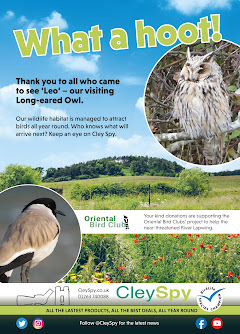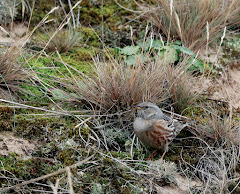Its been a very long day indeed - but an exciting one!
Burnham Overy Dunes
Got up in the dark and arrived at Burnham Overy Dunes parking spot just after sunrise. Walking out to the dunes with Eddie, we heard a Green Sandpiper, pink footed geese were flying south east, 2 Chiffchaffs in the hedges, robin and a bearded tit in the reed bed. Sat waiting for the Arctic Warbler to reappear so that I could hopefully achieve a nice sharp picture in the sunshine, but alas this was not to be. No sign of the pied fly that was there yesterday either - both birds presumably departed. Good movement of meadow pipits this morning, but little else. James Mc. had had a Richard's Pipit in the stubble field, east of the main road, where the cars are parked this morning. John F. phoned and very kindly asked if I would like to join him to go to East Hills, so off we went to meet John at an agreed time.
EAST HILLS
My first walk out here was incredibly exciting. Quite a few dykes and creeks had to be crossed and jumped (which a couple were only just made!) and it was an amazing place to be. BUT I certainly wouldn't venture out on my own, its much more complicated than one thinks. As you leave the dune ridge to return, the sands and marshes are vast and its difficult to work out your bearings. Hearing about the 'quick' sand would put you off going alone! But having said all this, the walk out and back was much easier physically, than doing Blakeney Point and much more beautiful. John, Eddie and I met up with James Mc. on the way out and between us we didn't find anything too exciting, although James did grip us off with 3 Lapland Buntings on his route out (not a recommended route, I understand!) and also a redstart later on. Here is the list of birds that we saw out there: spectacular views of a female Peregrine, 1 kestrel, 1 sparrowhawk, 1 song thrush, 1 lesser whitethroat, 1 chiffchaff, 1 reed bunting, 1 robin, 5 little egrets, hedgesparrow, wren and a whinchat. We arrived back mid afternoon.
After walking Burnham Overy Dunes and East Hills, we needed a snooze. We snoozed for an hour!
Please note: DO NOT VENTURE OUT TO EAST HILLS ALONE - I have waited a long time for someone to take me out here and it needs to be someone that has been out many, many times before. A birdwatcher died out here many years ago. Getting back in time/safely before the tide returns is also not as simple as it sounds, it depends on direction and speed of wind, weather conditions eg if mist came down, even the experienced would not be able to return as there is no definate path at all. Its not a case of just walking out across the marsh, walking on the beach and then over the dune ridge. You have to be walking a particular side of certain creeks one minute, a different side the next etc etc - there is no way I would remember it until I had been out a good number of trips!
Walsey Hills NOA - nothing in here apart from a chiffchaff calling. A few hirundines (mostly swallows) flew south over the bottom willows.
Coastguards - the odd gannet flying past, but little else.
Daukes Hide - too many people.
Teal Hide - 5 Yellow Leg Gulls, 41 Lapwing, 1 juv Spoonbill having a wonderful wash 'n' brush up - this bird arrived quite late in the evening. Huge number of gulls roosting here.
PHOTOGRAPHS TO BE ADDED
Subscribe to:
Post Comments (Atom)








































East Hills, like Scolt Head Island, is a birding destination that certainly requires planning before visiting. My first trip to each was with someone who knew the way (there are even more options to get to SHI than to EH) and I certainly echo Penny's recommendations on this front. I've since been back to both without 'guides' (inc. EH with my then 1yo daughter on my back), and a 1:25 000 map, a compass, a tide table, a (working) mobile phone, food and water were enough to stay safe & comfortable. My only other comment is that in the event of a rarity at either site, keep all of the above advice in mind (difficult though that might be)!
ReplyDeleteThanks for your advice Nick. Might be visiting EH over the next few days!
ReplyDelete